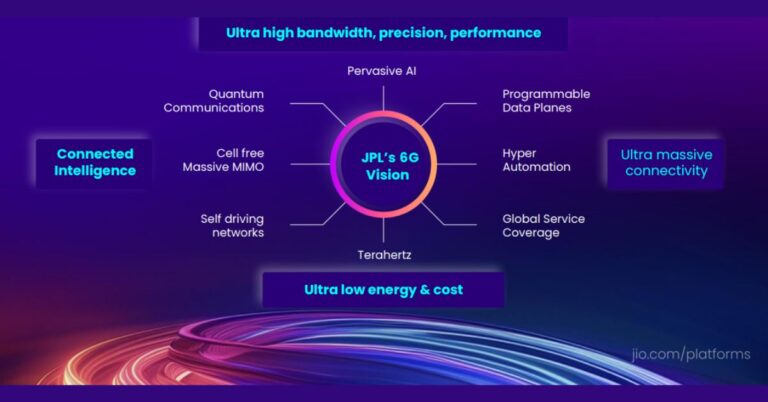Jio at IMC 2025: keeping India ahead in the digital future
At India Mobile Congress 2025, Jio framed a broad agenda that ties devices, networks, AI skills, and safety into a national-scale digital strategy.
India’s telecom stack: semiconductors to 6G leadership
The message from Jio’s chairman was clear: India’s telecom flywheel now spans the full value chain, from semiconductors and device platforms to fraud management and the next wave of 6G research. For operators and policymakers, this alignment matters. It links Make-in-India priorities and standards participation with the commercial realities of upgrading networks, hardening trust, and lifting digital productivity. As 3GPP continues its 5G-Advanced releases and 6G work items take shape, Indian players must keep turning R&D, testbeds, and domestic IP into deployable capabilities and exportable solutions.
Why this matters for telcos, enterprises, and edge-cloud plans
Telcos are shifting from pure connectivity to platform businesses that bundle devices, cloud access, security, and AI services. The IMC showcase underscores a pivot to lifecycle monetization, where value comes from managed experiences—learning, safety, fraud mitigation—delivered across low-cost phones, set-top boxes, and broadband. For enterprises, the takeaway is to plan for a denser edge-cloud, more managed devices at scale, and tighter integration between connectivity and AI-enabled applications.
JioPC and AI Classroom: scalable, service-led AI adoption
Jio is pairing an AI-ready thin-client style device with a foundational AI course to accelerate digital skills and access.
JioPC: pay-as-you-go cloud PC for education and SMBs
JioPC is positioned as an “AI-ready” computer that turns any screen into a managed endpoint, delivered through a subscription model. For CIOs, this resembles device-as-a-service meets cloud PC/VDI: centralized updates, reduced repair overheads, predictable opex, and a consistent security posture. In education and SMBs, that can unlock lower total cost of ownership, faster refresh cycles, and simpler compliance. The strategic play for Jio is twofold—attach services to endpoints and create a path for AI workloads to run close to the user via a controlled device footprint and edge-cloud integration.
AI literacy at scale: foundation to role-based skills
The free AI Classroom—Foundation Course, developed with Jio Institute, aims to onboard first-time learners through PCs, laptops, and even TVs via set-top boxes. For states, schools, and enterprises, it provides a quick way to seed AI literacy before investing in deeper curricula. The opportunity is to couple this foundational learning with role-based tracks (customer service, field ops, data entry automation) and hands-on projects that tie back to measurable productivity. The risk is stopping at awareness without building pathways to certifications, toolchains, and responsible AI practices. Leaders should define program outcomes, integrate capstones tied to real data and processes, and track completion-to-employment metrics.
JioBharat safety: trusted, inclusive features on entry-level phones
Jio is adding safety capabilities to its ultra-affordable JioBharat line to keep families connected and protected.
Safety-by-design for families and inclusion
By embedding always-on safety features into entry-level devices, Jio targets everyday scenarios—children commuting, seniors living alone, dependants needing basic check-ins. This approach aligns with India’s inclusion agenda: safety and presence awareness should not be premium features. For operators, it opens a services-led ARPU pathway on low-cost devices by bundling notifications, location sharing with consent, and escalation flows into family plans. Execution must prioritize privacy-by-design, explicit permissions, and simple controls to avoid surveillance creep or accidental data exposure.
Extending safety to workforce, public services, and IoT
These capabilities can extend to workforce management, community health programs, and asset tracking where lightweight, reliable communication is essential. Success depends on battery-efficient telemetry, resilient coverage, and straightforward APIs for enterprise integration. Compliance will be non-negotiable: data minimization, secure storage, consent records, and alignment with Indian data protection rules are required to de-risk scale deployments.
6G roadmap and fraud controls in India’s policy context
The industry narrative blends next-generation RAN ambitions with a hard push on spam and scam mitigation under regulatory guidance.
5G-Advanced ROI now, 6G testbeds and standards next
India’s 6G mission and testbeds will evolve through global standards, likely emphasizing spectrum efficiency, non-terrestrial integrations, network sensing, and tighter cloud-native control planes. The near-term imperative is to extract ROI from 5G and 5G-Advanced while contributing to pre-standard trials that build domestic know-how and patents. Operators should map spectrum needs, evaluate open and disaggregated architectures where they reduce TCO, and align with ecosystem bodies like TSDSI, 3GPP, and the O-RAN community to influence requirements relevant to India’s density and cost constraints.
AI-driven spam/scam mitigation and verified communications
COAI emphasized industry efforts to curb unwanted communications, a priority for both regulators and consumers. Expect continued application of AI/ML for anomaly detection, stronger KYC for communications channels, and tighter enforcement across voice, SMS, and OTT pathways. For enterprises, compliance is now table stakes: maintain clean sender reputations, adopt verified IDs, and ensure consent frameworks to avoid blocking. For telcos, trust services can be monetized through verified calling, brand authentication, and managed fraud analytics for large enterprises.
Action plan for telcos, enterprises, and policymakers
Jio’s announcements point to practical moves leaders can take now across networks, devices, talent, and trust.
Priorities for telcos and ISPs
Pilot device-as-a-service models with thin-client endpoints and managed security to reduce lifecycle costs. Bundle AI literacy with broadband and device offerings for SMEs and schools to drive stickiness. Treat safety features on affordable phones as a service opportunity with clear privacy controls. Balance 5G-Advanced upgrades with targeted 6G trials tied to specific use cases and IP creation. Double down on spam/scam mitigation with cross-channel analytics and transparent reporting to regulators.
Priorities for enterprises and the public sector
Use pay-as-you-go endpoints for labs, classrooms, and frontline roles where standardized software stacks matter more than raw compute. Deploy the AI foundation course at scale, but add role-based curricula, governance training, and productivity KPIs. Explore safety features for field teams and vulnerable populations with strict consent and audit trails. Integrate verified communications and sender authentication into CX and A2P strategies to protect brand trust.
Metrics to track and risks to manage
Track adoption and retention for JioPC and AI courses, ARPU uplift from safety and trust services, and capex-to-opex shifts from managed devices. Monitor privacy incidents, endpoint security posture, and supply chain continuity for device components. Watch standards timelines, domestic IPR generation, and testbed-to-deployment conversion rates as early indicators of 6G readiness. The winners will pair rapid rollout with disciplined governance and measurable business outcomes.








































